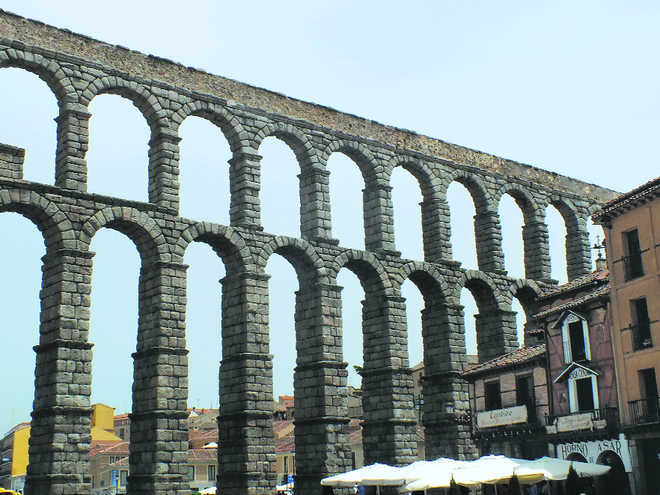
The aquaduct with 118 arches is at a height of 95 feet.
Ranjita Biswas
They say that no one could build aqueducts like the Romans. The proof lies in numerous locations of the once vast Roman Empire. Look at Segovia in Spain. The Roman aqueduct that you come across is more than 2,000 years old. Any image of Segovia will always feature this architectural marvel.
Like a giant toran, it waits to greet you as you approach the city. It’s an imposing sight indeed, rising to a height of 95 feet with 118 arches, covering a distance of 15 km. The Roman hydrologists built the aqueduct to fetch water from the mountains. There is not a single nail or mortar in this engineering feat — built stone by stone. In 1755, when the devastating earthquake shattered many edifices in Spain, and almost flattened the neighbouring Lisbon in Portugal, it could not dislodge Segovia’s aqueduct.
To enter the old town, off-limit to vehicles, you have to walk through one of the arches to a square called Azoguejo. The main tourist information office located here gives the relevant facts about the old town.
In 1985, the old city of Segovia and its aqueduct were declared a World Heritage Site by Unesco. Segovia reflects the glorious days of Castile reign in Spain. It was here that in the 15th century, Queen Isabella met King Ferdinand. The marriage of the Catholic monarchs united the two kingdoms of Castile and Aragon and led to one of the most important chapters in Spain’s history. Isabella was crowned Queen of Spain in Segovia’s Plaza Mayor-main square, and it was at the Alcazar (Moorish term for palace) that she promised Christopher Columbus financial backing for his discovery of a sea route to the fabulous East, including India. Instead, he landed in the new world of the Americas. But that’s another story.
The 12th century Alcazar is shaped like a boat. So it gets its name ‘floating castle’. The castle in Walt Disney’s Disneyland theme park is supposed to be modelled after it. A narrow hilly path leads to the spectacular palace. The cathedral in Segovia is the last Gothic cathedral built in Spain. Standing imposingly on Plaza Mayor inside are priceless antiques and rich stained glass windows.
Romans, Arabs, Jews and Christians have left behind their cultural mark in architecture, artefacts and heritage buildings of Segovia. The Jewish community was integrated into the society and had great presence and influence in Segovia. But when a more conservative Catholic priesthood took over, influencing the Spanish royalty, they were given an ultimatum: ‘convert or leave’. Hence most of the Jews left but many thought they would return and even left behind their belongings. Alas, it was a false hope. Today as you walk through the cobbled paths of the one-time Jewish quarters ‘La Juderia’ and pass the main synagogue (now the Convent of Corpus Christi), the sad chapter in the city’s history unfolds.
Apart from historical references, Segovia is also renowned for its cuisine. The most famous is the suckling pig dish. So soft it becomes after roasting it for hours, it’s not cut with a knife but a dinner plate, and then, it’s thrown to the floor as proof! Another specialty is kidney bean ‘Jodiones de la Granja’ done in Segovian style. The local dessert Ponche Segoviano is delicious and light with custard and egg with a dash of orange. For the curio lover, Segovia has a plenty of interesting things to take home — handcrafted ceramic tiles, jewellery, leatherwork, fabrics, to name a few.
Today with superfast trains and many day-tours available from Madrid, most tourists ‘do’ Segovia as a side trip. But Segovia deserves more time to explore because it also has a great hinterland with national parks, rivers with gorges where eagles nest, and quaint village with their own cuisine.
Fact File
- How to get there: Both road and train transport are available for Segovia, which is 91 km from Madrid.
- What to do: Explore the city by walking. Sample local food.
- What to eat: The old town is popular for its cuisine. Do try out local delicacies, especially desserts like Ponche Segoviano.
- What to buy: Ceramic tiles and souvenirs


























